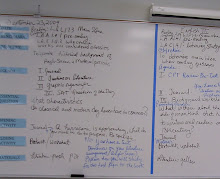This month Intern Principals Cindy Pluim and John Vetter present a timely update on Professional Learning Communities (PLC) and the evolving cultural shift in the purpose and activities of the PLC.
Professional Learning Communities are driven by a sense of purpose and clear goals. A key component of all school-based PLCs is student achievement. According to Shirley Hord, Southwest Educational Development Laboratory, Professional Learning Communities’ research suggests that teachers learn best from and with each other in ongoing, job-embedded activities.
In education circles, the term learning communities has become commonplace. It is being used to mean any number of things, such as extending classroom practice into the community, bringing community personnel into the school to enhance the curriculum and learning tasks for students, or engaging students, teachers, and administrators simultaneously in learning-to suggest just a few.
The leading researchers on professional learning communities (PLC) are probably not strangers to anyone in education. Richard and Rebecca Dufour, Robert Eaker and Dr. Robert Marzano have done extensive work in the field. Unfortunately, the term PLC has been overused so much that the terminology needs to be revisited.
The term professional learning community describes a collegial group of administrators and school staff who are united in their commitment to student learning. They share a vision, work and learn collaboratively, visit and review other classrooms, and participate in decision-making (Hord, 1997b). The benefits to the staff and students include a reduced isolation of teachers, better-informed and committed teachers, and academic gains for students. Hord (1997b) notes, "As an organizational arrangement, the professional learning community is seen as a powerful staff-development approach and a potent strategy for school change and improvement."
The attributes of a Professional Learning Community are: (1) Supportive and shared leadership, (2) Collective creativity, (3) Shared values and vision, (4) Supportive conditions, and (5) Shared personal practice according to Rosenholtz (1989).
One school has won the Blue Ribbon School award four times. This means they have sustained forward educational progress for twenty years in a row. The school is Stevenson Adlai Stevenson High School in Lincolnshire Nebraska. The power of the professional learning community is evident. This school is one of many examples of a true PLC at work.
The PLC is not a group but instead a new way working together. It is a complete culture change for MANY schools and businesses.
Review the attachments labeled Cultural Shifts in a PLC and reflect on this… Is my school ready to focus on student learning and willing to work as a team to do it? Are we willing to challenge the norm and recognize that the system we are currently using is outdated and needs to be fixed? Are we willing to start tomorrow and not wait for the right time?
What specific steps would you take as a Principal to ensure your school staff will share the Professional Learning Community mentality and model it throughout the school year? Post your comment(s) below.
Monday, October 4, 2010
Subscribe to:
Post Comments (Atom)








1 comment:
As the Principal of a School it is important to provide structure for Professional Learning Communities, opportunities, time, support, as well as being an active participant.
I agree that the term PLC is over used. The leaders of the school need to be sure that the there is a clear understanding of expectations among the faculty.
Post a Comment